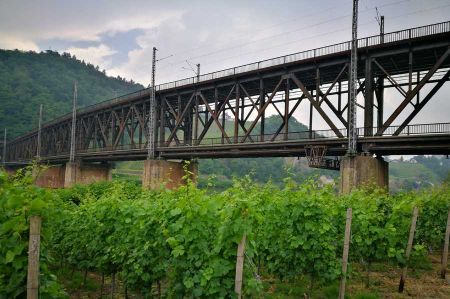Crossing the Moselle using the double-decker bridge Alf-Bullay
- Written by Portal Editor
Our discovery tour along the Moselle also led us to cross the iron double-decker bridge at Alf-Bullay, a special relic of 19th-century railway road construction technology, which is considered to be the first double-decker bridge in Germany.
The 314 meter long bridge was built in the years 1875-1878 with the construction of the railway line Koblenz - Trier in the course of the construction of the so-called cannon railway for troops and weapon transport to the west. At first it was planned as a pure railway bridge. After the surrounding communities and the district and entrepreneurs involved financially, the then Prussian government approved the construction of a double-decker bridge for rail and road. After crossing the railway line using the combined railway and road bridge, it directly continued into the Prinzenkopftunnel on the other side of the Moselle.
Bridge Monument also part of the cultural route Kanonenbahn
The box-shaped steel grid construction with a total weight of 1400 tons spans the Moselle with six single-span girders and five river piers. With increasing transport volume, the bridge had to be rebuilt and reinforced in 1928-1929. The building is unique in Germany, together with the two double-decker bridges of the Biggetalbahn. During the Second World War, the supply to the Western Front was done over the bridge, so since 1944 was often target of Allied bombing. On February 10, 1945, it was destroyed in an air raid by four P-47D Thunderbolts of the 368th Fighter Group of the United States Army Air Forces (USAAF).After approval of the French military governor Marie-Pierre Kœnig, the bridge was rebuilt and put into operation on April 24, 1947.
Hiking tour along the cultural route Kanonenbahn
The double-decker bridge Alf-Bullay is also one of the highlights of the cultural route Kanonenbahn, a hiking trail passing tunnels, viaducts and impressive bridges and to Marienburg. "The Kanonenbahn - the historical railway culture path Bullay-Reil", was re-opened in September 2005 and has become a popular attraction on the Moselle.
Impressive railway architecture, embedded in the unique wine culture landscape Moselle, offers the adventurous hiking trail around the communities Alf, Briedel, Bullay, Puenderich, Zell (Mosel) and Reil, as part of the Mosel experience route. The fantastic panoramic view from the Marienburg or the Prinzenkopf observation tower, one of the most striking points on the Moselle, makes the railway landscape appear like a "Märklin toy country". As early as 1818, this impressive view cast a spell over the crown prince and later King Friedrich Wilhelm IV.
Ambitious hikers encounter relics of the railway culture
As a joint project of different Moselle Communities the historic railway trail was created. On the route, information boards explain the history of the canon railway and two adjacent railway lines. Along various witnesses of Prussian transport and construction engineering, the 8.5 km long main axis of the themed hiking route leads from the Bullay environmental station, crossing the first double-decker bridge (1877) in Germany to Marienburg, past the mighty railway-viaduct of Pünderich from 1880, which Its 92 segmental arches and 786 m making it the longest one in Germany, until the station Reil.
Ambitious hikers can continue on the opposite side of the Moselle to Pünderich, at the former railway stations in Briedel, Zell (Moselle) and Zell-Merl to the starting point Bullay follow the culture trail and experience the evidence of the former Moselle railway.
Informative information panels on the one hand convey the original military-strategic function of this "canon train" from Berlin to Metz with east-west connections and on the other hand the economic and cultural significance for the Moselle region and the Moselle railway as so-called "Saufbähnchen". Interesting insights and views, not only for railroad freaks, as also typical topics such as viticulture, architecture, animal and plant life and geology are taken into account.
Coordinates: 50°02'53.1"N 7°07'55.6"E 50.048087, 7.132096
Nürburgring - Grand Prix Circuit - Passing Ahr valley to Altenahr
Lilac - not just gorgeous flowers and scents
-
 Iron-Railway-Roadbridge at Alf-Bullay Moselle
Iron-Railway-Roadbridge at Alf-Bullay Moselle
Iron-Railway-Roadbridge at Alf-Bullay Moselle
Iron-Railway-Roadbridge at Alf-Bullay Moselle
-
 Iron-Railway-Roadbridge at Alf-Bullay Moselle
Iron-Railway-Roadbridge at Alf-Bullay Moselle
Iron-Railway-Roadbridge at Alf-Bullay Moselle
Iron-Railway-Roadbridge at Alf-Bullay Moselle
-
 Iron-Railway-Roadbridge at Alf-Bullay Moselle
Iron-Railway-Roadbridge at Alf-Bullay Moselle
Iron-Railway-Roadbridge at Alf-Bullay Moselle
Iron-Railway-Roadbridge at Alf-Bullay Moselle
-
 Iron-Railway-Roadbridge at Alf-Bullay Moselle
Iron-Railway-Roadbridge at Alf-Bullay Moselle
Iron-Railway-Roadbridge at Alf-Bullay Moselle
Iron-Railway-Roadbridge at Alf-Bullay Moselle
-
 Iron-Railway-Roadbridge at Alf-Bullay Moselle
Iron-Railway-Roadbridge at Alf-Bullay Moselle
Iron-Railway-Roadbridge at Alf-Bullay Moselle
Iron-Railway-Roadbridge at Alf-Bullay Moselle
-
 Iron-Railway-Roadbridge at Alf-Bullay Moselle
Iron-Railway-Roadbridge at Alf-Bullay Moselle
Iron-Railway-Roadbridge at Alf-Bullay Moselle
Iron-Railway-Roadbridge at Alf-Bullay Moselle
https://www.alaturka.info/en/turkey-country/journey/23-deutschland/rheinland-pfalz/4489-crossing-the-moselle-using-the-double-decker-bridge-alf-bullay#sigProIdd59942cbb4

